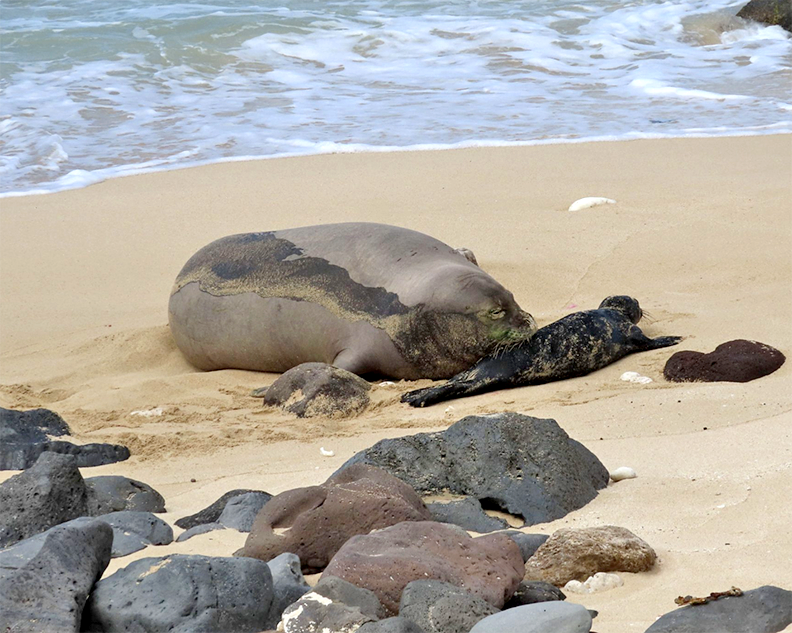
For Kaua`i May 2012 Cover. Bee Friendly — Jimmy Trujillo Helps KCC Catch the Buzz. Cover photo by Keri Cooper
by Joan Conrow
Folks all over Kaua`i are getting buzzed about bees.
They’re beginning to realize that honey bees, which pollinate fruits and vegetables, are facing serious environmental threats.
“There’s an awareness that bees are important for a number of reasons and we can’t just sit back and hope they’ll recover,” says Dr. Francis Takahashi, electronics instructor at Kaua`i Community College.
Takahashi has created a focus for that interest with the KCC “bee lab” and apiary, a place where aspiring beekeepers can see the equipment they’ll need and “learn the best practices from A to Z.” The other half of the bee booster team is Jimmy Trujillo of the Kaua`i Beekeeper’s Assn. (KBEE). He does community outreach and teaches classes.
“What we’re kind of hoping is to provide that full spectrum, from education to services,” Trujillo says.
It all started when KCC Chancellor Helen Cox asked the faculty for ideas on how the college could support sustainability. Takahashi suggested a program about bees, which are critical to successful agriculture. But the beneficial insects are vulnerable on Kauai, because most of the populations are wild and few people know how to rear the healthy queens that are key to a vibrant colony.
The idea became reality when Sen. Daniel Inouye secured a $53,00 Kaua`i Rural Development Project grant that covered the cost of setting up the bee lab in a portable building next to the Tech Center. The campus apiary, which began with 10 hives donated by longtime island beekeeper Oliver Shagnasty, has steadily grown, offering aspiring beekeepers a chance at hands-on practice, while producing honey and wax to make the program self-sustaining.
Underlying it all is the message of using “best practices” to maintain healthy hives and prevent the dreaded varroa mite and small hive beetle from getting established here. The parasites have already impacted hives on the mainland and were introduced to Hawai`i several years ago. Currently, Kaua`i is the only main island that doesn’t have either of the pests, which typically require a chemical pesticide treatment of the hive that can contaminate the wax and honey.
Since Kaua`i beekeepers don’t need to treat their hivest, “our honey is about as pure and organic as you can get,” Takahashi says. “We’re a neutral entity here.”
Trujillo wants to keep it that way, which is why he became a founding member of KBEE in 2009 and got involved with the KCC project. “We’re trying to stay one step ahead of the mite and beetle with education and outreach, bringing in new beekeepers,” he says. “We’ve got a good facility and a good program that will help them learn more.”
The program is designed to support people who are curious about any aspect of beekeeping, from building bee boxes and harvesting honey to producing products from wax. It also offers more specialized training “to help people grow apiaries,” Takahashi says. Bees cannot be imported to Kaua`i because of the disease problems elsewhere, so hives can only be created by trapping wild swarms, splitting hives, rearing queens or removing them from buildings.
Takahashi started raising bees when they were extracted from the walls of his grandmother’s house, prompting him to brand his honey Obachan’s Bees. Trujillo caught the beekeeping bug after taking a class and setting up hives in Kapahi.
“If we get the varroa mite, the bees are better able to fend it off if they’re in managed hives rather than feral colonies,” Trujillo says.
Takahashi would like to develop a process for rearing disease-resistant queens, and Trujillo also sees the program growing as it builds on partnerships formed with the University of Hawai`i, Kaua`i County and state Department of Agriculture. Ideas for the future include a new course on business education for farmers, and perhaps a co-op to help small beekeepers distribute and sell their hive products.
But even people who aren’t likely to erect a hive in the backyard can still give bees a break.
“Just ‘bee friendly,’ Trujillo says, referencing the KBEE logo. “Think about not using pesticides, and planting shrubs and plants that bees like to forage on. They love herbs. If you do get an unwanted swarm in your yard or house, call a beekeeper before poisoning.”
Adds Takahashi: “Support your local beekeeper and eat local honey.”
The KCC honey is currently sold at the bee lab. Honey produced by other Kaua`i beekeepers can be found at farmer’s markets and some island stores.
For more information contact Trujillo at 346-7725 or jtrujill@hawaii.edu.
Bee Basics
• Hives have one queen, a lot of workers and a few drones.
• Females do all the work.
• Males are drones, and mate with the queen.
• Worker bees live for 35 to 42 days.
• Queens live two to three years — or as long as eight if they’re treated well.
• An average hive will have 35,000 to 50,000 bees.
• A honey bee dies after it stings.
Good rule of thumb: If you let the bee be, the bee will let you be.

Lihu`e Airport window display on the subject of bees. May issue of "For Kaua`i" with cover story "Bee Friendly" is at top left in window. Photo by Carol K. Yotsuda
Editor’s Note: The May print edition of For Kaua`i had just come out as the Garden Island Arts Council, under the direction of GIAC Executive Director Carol K. Yotsuda, began installing an exhibit about bees in the display window on the Hawaiian Airlines end of the airport. For Kaua`i offered its cover for the display; copies of the issue are available in baggage claim throughout the month.
Discover more from ForKauaiOnline
Subscribe to get the latest posts sent to your email.










Leave a Reply